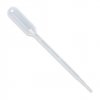I ran the test the same way you did, checking 94 once fired cases. The overall variance in case weight was 8 grains, while the overall variance in internal volume was 3.9 grains.
91 of 94 cases had an internal volume between 69.2 and 70.4 grains. Of the three outliers, only one would have been an obvious cull by case weight alone. The case weight of the remaining 91 ranged from 192.6 to 199.5 grains. The three outliers weighed 200.6, 199.5, and 198.4 grains, having internal volumes of 68.8, 66.5, and 66.8 grains, respectively. Only one of them would have been an obvious outlier by case weight. 93 of 94 cases tested showed ZERO relationship between case weight and internal volume.
If uniform case volume is the objective, the only way to reliably achieve that is by actually measuring the volume. If you feel like you are accomplishing something by weight sorting your cases, go ahead. It's your time. Waste it how you wish.
If I'm reading that correctly, we were about 180 degrees different in the test results. Mine would have sorted 80% correct by case weight and only 20% of yours did. May be the difference in the source brass, your mil spec 30-06 and mine Hornady 6.5 and Norma 300 WSM.
I numbered each case and recorded its weight and case volume, then sorted the results via spreadsheet. It was easy to pick out the couple of exact ones that sorted differently by weight versus volume.
Like they say your results may vary..... I am not exactly jumping up and down at the fact that 2 out of 10 pieces of my brass don't correlate. Cause I know that's one of the ones I will pull out when I need it the most. LOL. But for trying to work up a load or practice, I don't worry about it too much. I keep 50 cartridges of each that are golden. They are sorted by volume, annealed and have the same number of firings. The Berger bullets are also sorted by weight and bearing surface. These are what I am elk hunting with in eastern Oregon with this year. I'm a bad shot, I need all the help I can get...

